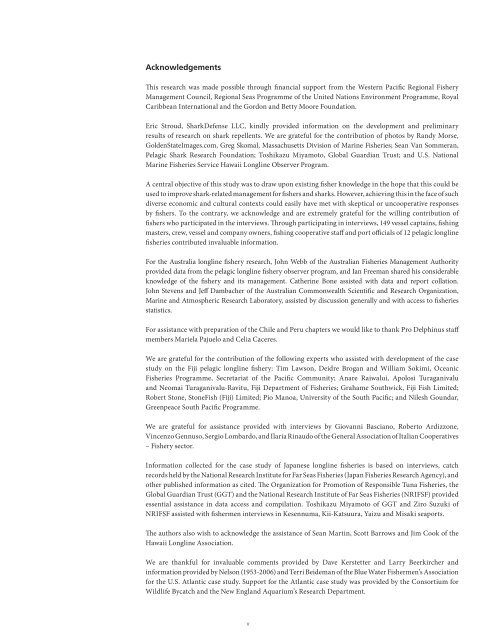Shark Depredation and Unwanted Bycatch in Pelagic Longline
Shark Depredation and Unwanted Bycatch in Pelagic Longline
Shark Depredation and Unwanted Bycatch in Pelagic Longline
Create successful ePaper yourself
Turn your PDF publications into a flip-book with our unique Google optimized e-Paper software.
Acknowledgements<br />
This research was made possible through f<strong>in</strong>ancial support from the Western Pacific Regional Fishery<br />
Management Council, Regional Seas Programme of the United Nations Environment Programme, Royal<br />
Caribbean International <strong>and</strong> the Gordon <strong>and</strong> Betty Moore Foundation.<br />
Eric Stroud, <strong>Shark</strong>Defense LLC, k<strong>in</strong>dly provided <strong>in</strong>formation on the development <strong>and</strong> prelim<strong>in</strong>ary<br />
results of research on shark repellents. We are grateful for the contribution of photos by R<strong>and</strong>y Morse,<br />
GoldenStateImages.com, Greg Skomal, Massachusetts Division of Mar<strong>in</strong>e Fisheries; Sean Van Sommeran,<br />
<strong>Pelagic</strong> <strong>Shark</strong> Research Foundation; Toshikazu Miyamoto, Global Guardian Trust; <strong>and</strong> U.S. National<br />
Mar<strong>in</strong>e Fisheries Service Hawaii Longl<strong>in</strong>e Observer Program.<br />
A central objective of this study was to draw upon exist<strong>in</strong>g fisher knowledge <strong>in</strong> the hope that this could be<br />
used to improve shark-related management for fishers <strong>and</strong> sharks. However, achiev<strong>in</strong>g this <strong>in</strong> the face of such<br />
diverse economic <strong>and</strong> cultural contexts could easily have met with skeptical or uncooperative responses<br />
by fishers. To the contrary, we acknowledge <strong>and</strong> are extremely grateful for the will<strong>in</strong>g contribution of<br />
fishers who participated <strong>in</strong> the <strong>in</strong>terviews. Through participat<strong>in</strong>g <strong>in</strong> <strong>in</strong>terviews, 149 vessel capta<strong>in</strong>s, fish<strong>in</strong>g<br />
masters, crew, vessel <strong>and</strong> company owners, fish<strong>in</strong>g cooperative staff <strong>and</strong> port officials of 12 pelagic longl<strong>in</strong>e<br />
fisheries contributed <strong>in</strong>valuable <strong>in</strong>formation.<br />
For the Australia longl<strong>in</strong>e fishery research, John Webb of the Australian Fisheries Management Authority<br />
provided data from the pelagic longl<strong>in</strong>e fishery observer program, <strong>and</strong> Ian Freeman shared his considerable<br />
knowledge of the fishery <strong>and</strong> its management. Cather<strong>in</strong>e Bone assisted with data <strong>and</strong> report collation.<br />
John Stevens <strong>and</strong> Jeff Dambacher of the Australian Commonwealth Scientific <strong>and</strong> Research Organization,<br />
Mar<strong>in</strong>e <strong>and</strong> Atmospheric Research Laboratory, assisted by discussion generally <strong>and</strong> with access to fisheries<br />
statistics.<br />
For assistance with preparation of the Chile <strong>and</strong> Peru chapters we would like to thank Pro Delph<strong>in</strong>us staff<br />
members Mariela Pajuelo <strong>and</strong> Celia Caceres.<br />
We are grateful for the contribution of the follow<strong>in</strong>g experts who assisted with development of the case<br />
study on the Fiji pelagic longl<strong>in</strong>e fishery: Tim Lawson, Deidre Brogan <strong>and</strong> William Sokimi, Oceanic<br />
Fisheries Programme, Secretariat of the Pacific Community; Anare Raiwalui, Apolosi Turaganivalu<br />
<strong>and</strong> Neomai Turaganivalu-Ravitu, Fiji Department of Fisheries; Grahame Southwick, Fiji Fish Limited;<br />
Robert Stone, StoneFish (Fiji) Limited; Pio Manoa, University of the South Pacific; <strong>and</strong> Nilesh Goundar,<br />
Greenpeace South Pacific Programme.<br />
We are grateful for assistance provided with <strong>in</strong>terviews by Giovanni Basciano, Roberto Ardizzone,<br />
V<strong>in</strong>cenzo Gennuso, Sergio Lombardo, <strong>and</strong> Ilaria R<strong>in</strong>audo of the General Association of Italian Cooperatives<br />
– Fishery sector.<br />
Information collected for the case study of Japanese longl<strong>in</strong>e fisheries is based on <strong>in</strong>terviews, catch<br />
records held by the National Research Institute for Far Seas Fisheries (Japan Fisheries Research Agency), <strong>and</strong><br />
other published <strong>in</strong>formation as cited. The Organization for Promotion of Responsible Tuna Fisheries, the<br />
Global Guardian Trust (GGT) <strong>and</strong> the National Research Institute of Far Seas Fisheries (NRIFSF) provided<br />
essential assistance <strong>in</strong> data access <strong>and</strong> compilation. Toshikazu Miyamoto of GGT <strong>and</strong> Ziro Suzuki of<br />
NRIFSF assisted with fishermen <strong>in</strong>terviews <strong>in</strong> Kesennuma, Kii-Katsuura, Yaizu <strong>and</strong> Misaki seaports.<br />
The authors also wish to acknowledge the assistance of Sean Mart<strong>in</strong>, Scott Barrows <strong>and</strong> Jim Cook of the<br />
Hawaii Longl<strong>in</strong>e Association.<br />
We are thankful for <strong>in</strong>valuable comments provided by Dave Kerstetter <strong>and</strong> Larry Beerkircher <strong>and</strong><br />
<strong>in</strong>formation provided by Nelson (1953-2006) <strong>and</strong> Terri Beideman of the Blue Water Fishermen’s Association<br />
for the U.S. Atlantic case study. Support for the Atlantic case study was provided by the Consortium for<br />
Wildlife <strong>Bycatch</strong> <strong>and</strong> the New Engl<strong>and</strong> Aquarium’s Research Department.












